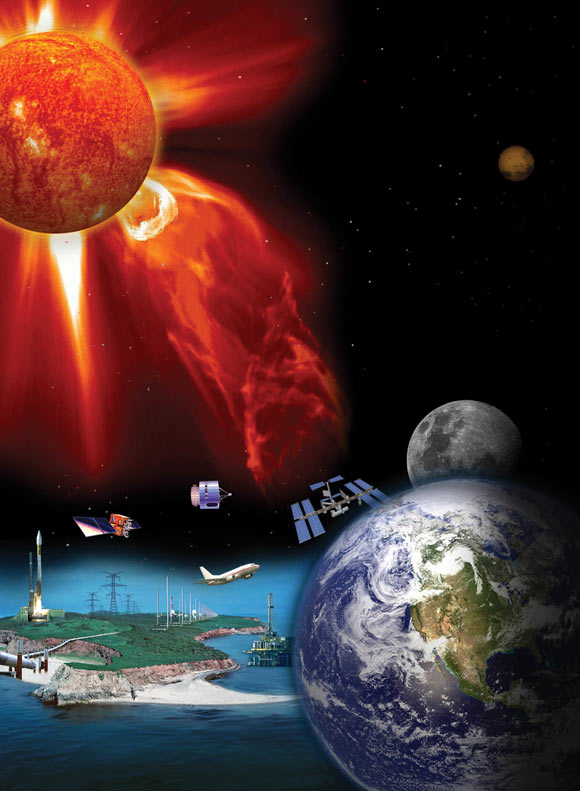During solar storms, the Sun expels large amounts of energetic particles that can react with the atmosphere of Earth and produce cosmogenic isotopes such as carbon-14 (14C), beryllium-10 (10Be) and chlorine-36 (36Cl). In new research, an international team of scientists measured the amounts of 10Be and 36Cl isotopes in ice cores from Greenland and Antarctica. Their data consistently show one of the largest 10Be and 36Cl production peaks detected so far, most likely produced by an extreme solar storm that hit Earth around 7176 BCE. What puzzles the authors is that the storm took place during one of the Sun’s more quiet phases — during which it is generally believed our planet is less exposed to such events.

Many technologies key to modern society are vulnerable to solar storms. Image credit: National Space Weather Program.
“Solar energetic particle (SEP) events occur when abrupt eruptive events on the surface of the Sun, such as coronal mass ejections and solar flares, accelerate particles into the interplanetary medium,” said Lund University’s Professor Raimund Muscheler and colleagues.
“These particles — mostly protons — can eventually reach the Earth guided by the heliospheric magnetic field lines.”
“In the last decades, great attention has been dedicated to solar storms due to the high vulnerability of our modern society to such events.”
“SEP events can, in fact, have serious repercussions on communication and power systems, satellite life expectancy and aircraft operations. For instance, during the so-called ‘Halloween storms’ of 2003, parts of Europe were left without electricity for several hours, and transformers in South Africa were permanently damaged, with enormous costs for society.”
“In addition, the life of astronauts in space could be endangered due to high radiation exposure connected to SEPs.”
In the study, the scientists scoured the drill cores from Greenland and Antarctica for peaks of 10Be and 36Cl radionuclides.
They discovered traces of a massive SEP event that hit Earth during one of the Sun’s passive phases about 9,200 years ago.
“This is time consuming and expensive analytical work. Therefore, we were pleasantly surprised when we found such a peak, indicating a hitherto unknown giant solar storm in connection with low solar activity,” Professor Muscheler said.
“If a similar solar storm were to take place today, it could have devastating consequences.”
“In addition to power outages and radiation damage to satellites, it could pose a danger to air traffic and astronauts as well as a collapse of various communication systems.”
“These enormous storms are currently not sufficiently included in risk assessments,” he said.
“It is of the utmost importance to analyze what these events could mean for today’s technology and how we can protect ourselves.”
The results appear in the journal Nature Communications.
_____
C.I. Paleari et al. 2022. Cosmogenic radionuclides reveal an extreme solar particle storm near a solar minimum 9125 years BP. Nat Commun 13, 214; doi: 10.1038/s41467-021-27891-4







